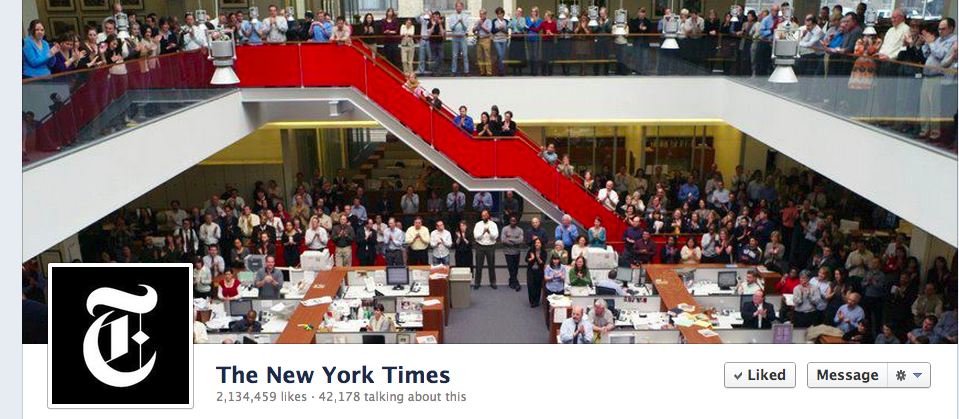
Digital media has long favored the young. Newer entrants didn’t have the legacies of the dinosaurs they sought to replace. But in some ways, Facebook is giving power back to legacy publishing companies, at least with its shift to Timeline for company pages.
Last week Facebook rolled out its Timeline for brands, and media properties were quick to show off how deep into archives they could go. The Timeline is meant as a better way for Facebook residents to present themselves in unique ways. Media outlets are no exception. Whether it’s taking you all the way back to when the outlet was founded or highlighting coverage from historical events, media outlets can use Facebook as a way to draw readers into their worlds.
“They have to figure it out,” said Dave Marsey, group media director at Digitas. “It’s interesting because there’s a lot of news archives for the nostalgic out there.”
We took a look at what some of the more traditional outlets — and a recent entrant — are doing on Facebook as these publications try to find new ways of interacting and engaging with readers.
The New York Times
The Gray Lady greets you with a panoramic image of its two-floor newsroom. Icons take you to NYT photos and events. The paper of record uses its Timeline to share articles, but also to get opinions from its audience. Besides current news, the company revisits its own history (like its October 1907 update informing readers that it is the first newspaper to use wireless transmissions) as well as significant events that it has covered since the paper’s first issue in 1851, like the sinking of the Titanic in 1912.
The Wall Street Journal
The Journal’s Timeline starts with an image of a variety of cameras — from old ones like a Brownie Hawking model to the iPhone — which corresponds to a WSJ article asking if the iPhone is the only camera you need. This is a good example of how a media outlet can get additional legs from a recent story: highlight it on Timeline. Rupert Murdoch’s paper’s timeline starts in 1889, when it was founded by Charles Dow, Edward Jones and Charles Bergstresser to give “operators, bankers and capitalists” the financial news they needed. All these years later, while its core competency is still financial news, the paper has evolved to include more general news, and its use of Facebook’s Timeline (as well as its Facebook app, WSJ Social) is an adaptive way to find different audiences.
The New Yorker
The New Yorker has defined cultural criticism and high-minded journalism since it was founded in 1925 by Harold Ross. In its Timeline, the Conde Nast-owned magazine dives into its archives to let readers see the artful and often iconic covers, its sardonic cartoons, as well as articles from some of the 20th century’s most famous writers: F. Scott Fitzgerald, William Butler Yeats, William Carlos Williams, James Thurber and Vladimir Nabokov, to name a few. For non-subscribers, the New Yorker’s Timeline is a great way to see these classic articles, stories, poems and art designs. Additionally, the magazine posts links to select recent stories and to preview what’s coming up in the next edition.
The Atlantic
The Atlantic publishes only 10 magazines a year but has beefed up its digital presence with The Atlantic Wire and The Atlantic Cities. The outlet started as a literary publication — founders include Harriet Beecher Stowe, Ralph Waldo Emerson, Henry Wadsworth Longfellow and Oliver Wendell Holmes, Sr. — and has evolved into one of the preeminent media outlets in the world. The Atlantic uses the Timeline to highlight some of its treasured pieces, but also shows some amazing corresponding images. The Atlantic also has an interactive poll on Facebook for its readers, another example of using Facebook to engage with an audience. Jared Keller mans the Timeline and uses current events as one of the ways to tie into archival Atlantic stories. In a Twitter exchange, he said, “For example, if (Timeline) had been up during the Komen kerfuffle, I would’ve surfaced dueling 1939 pieces on contraception.”
Hulu
Hulu’s only been around four years, but TV’s been around much longer. Instead of doing a company timeline, it starts at the 1900 World’s Fair, where “television” was first described. Hulu then gives us television’s trajectory: from a technological perspective (John Baird’s 30 lines of resolution at five frames per second in 1926 and the first color broadcast in 1953) to some of TV’s most iconic moments (series launches and news events like the JFK assassination). The company also links to recent television shows and films while engaging its audiences through the comments section.
More in Media

Digiday Scorecard: Publishers rate Big Tech’s AI licensing deals
Digiday has compiled a scorecard grading AI platforms to make sense of the growing number of players in the AI content licensing market.

Publishers are hunting for AI prompt data — now they’re starting to get it from third-party companies
Publishers are finally gaining some visibility into AI search, as new prompt data tools crack open a black box.

Digiday+ Research: Publishers’ growing focus on video doesn’t translate to social platforms
Major publishers have made recent investments in vertical video, but that shift is not carrying over to social media platforms.





